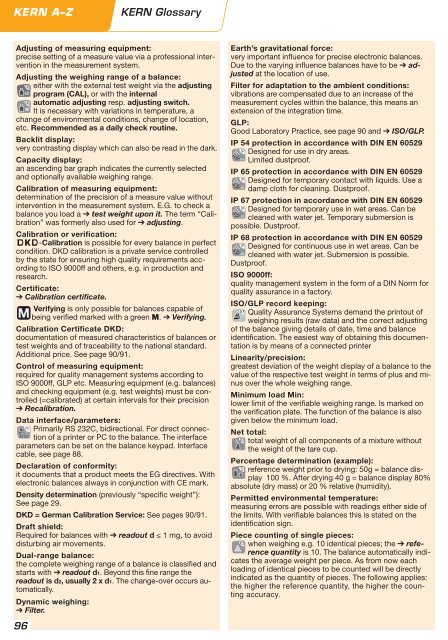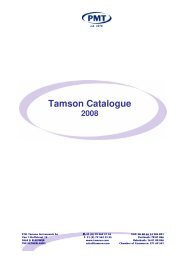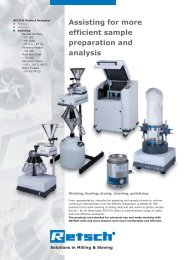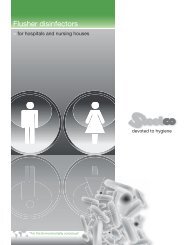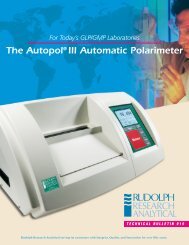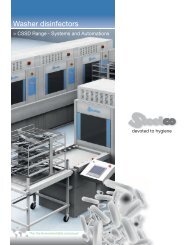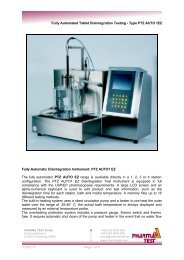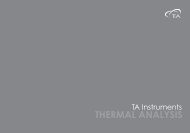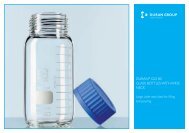KERN FIS Fully encapsulated stainless steel scale ... - Labochema
KERN FIS Fully encapsulated stainless steel scale ... - Labochema
KERN FIS Fully encapsulated stainless steel scale ... - Labochema
Create successful ePaper yourself
Turn your PDF publications into a flip-book with our unique Google optimized e-Paper software.
<strong>KERN</strong> A–Z<br />
<strong>KERN</strong> Glossary<br />
Adjusting of measuring equipment:<br />
precise setting of a measure value via a professional intervention<br />
in the measurement system.<br />
Adjusting the weighing range of a balance:<br />
either with the external test weight via the adjusting<br />
program (CAL), or with the internal<br />
automatic adjusting resp. adjusting switch.<br />
It is necessary with variations in temperature, a<br />
change of environmental conditions, change of location,<br />
etc. Recommended as a daily check routine.<br />
Backlit display:<br />
very contrasting display which can also be read in the dark.<br />
Capacity display:<br />
an ascending bar graph indicates the currently selected<br />
and optionally available weighing range.<br />
Calibration of measuring equipment:<br />
determination of the precision of a measure value without<br />
intervention in the measurement system. E.G. to check a<br />
balance you load a ➔ test weight upon it. The term “Calibration”<br />
was formerly also used for ➔ adjusting.<br />
Calibration or verification:<br />
-Calibration is possible for every balance in perfect<br />
condition. DKD calibration is a private service controlled<br />
by the state for ensuring high quality requirements acc -<br />
ording to ISO 9000ff and others, e.g. in production and<br />
research.<br />
Certificate:<br />
➔ Calibration certificate.<br />
Verifying is only possible for balances capable of<br />
M being verified marked with a green M. ➔ Verifying.<br />
Calibration Certificate DKD:<br />
documentation of measured characteristics of balances or<br />
test weights and of traceability to the national standard.<br />
Additional price. See page 90/91.<br />
Control of measuring equipment:<br />
required for quality management systems according to<br />
ISO 9000ff, GLP etc. Measuring equipment (e.g. balances)<br />
and checking equipment (e.g. test weights) must be controlled<br />
(=calibrated) at certain intervals for their precision<br />
➔ Recalibration.<br />
Data interface/parameters:<br />
Primarily RS 232C, bidirectional. For direct connection<br />
of a printer or PC to the balance. The interface<br />
parameters can be set on the balance keypad. Interface<br />
cable, see page 88.<br />
Declaration of conformity:<br />
it documents that a product meets the EG directives. With<br />
electronic balances always in conjunction with CE mark.<br />
Density determination (previously “specific weight”):<br />
See page 29.<br />
DKD = German Calibration Service: See pages 90/91.<br />
Draft shield:<br />
Required for balances with ➔ readout d ≤ 1 mg, to avoid<br />
disturbing air movements.<br />
Dual-range balance:<br />
the complete weighing range of a balance is classified and<br />
starts with ➔ readout d1. Beyond this fine range the<br />
readout is d2, usually 2 x d1. The change-over occurs automatically.<br />
Dynamic weighing:<br />
➔ Filter.<br />
96<br />
Earth’s gravitational force:<br />
very important influence for precise electronic balances.<br />
Due to the varying influence balances have to be ➔ ad -<br />
justed at the location of use.<br />
Filter for adaptation to the ambient conditions:<br />
vibrations are compensated due to an increase of the<br />
measurement cycles within the balance, this means an<br />
extension of the integration time.<br />
GLP:<br />
Good Laboratory Practice, see page 90 and ➔ ISO/GLP.<br />
IP 54 protection in accordance with DIN EN 60529<br />
Designed for use in dry areas.<br />
Limited dustproof.<br />
IP 65 protection in accordance with DIN EN 60529<br />
Designed for temporary contact with liquids. Use a<br />
damp cloth for cleaning. Dustproof.<br />
IP 67 protection in accordance with DIN EN 60529<br />
Designed for temporary use in wet areas. Can be<br />
cleaned with water jet. Temporary submersion is<br />
possible. Dustproof.<br />
IP 68 protection in accordance with DIN EN 60529<br />
Designed for continuous use in wet areas. Can be<br />
cleaned with water jet. Submersion is possible.<br />
Dustproof.<br />
ISO 9000ff:<br />
quality management system in the form of a DIN Norm for<br />
quality assurance in a factory.<br />
ISO/GLP record keeping:<br />
Quality Assurance Systems demand the printout of<br />
weighing results (raw data) and the correct adjusting<br />
of the balance giving details of date, time and balance<br />
identification. The easiest way of obtaining this documentation<br />
is by means of a connected printer<br />
Linearity/precision:<br />
greatest deviation of the weight display of a balance to the<br />
value of the respective test weight in terms of plus and minus<br />
over the whole weighing range.<br />
Minimum load Min:<br />
lower limit of the verifiable weighing range. Is marked on<br />
the verification plate. The function of the balance is also<br />
given below the minimum load.<br />
Net total:<br />
total weight of all components of a mixture without<br />
the weight of the tare cup.<br />
Percentage determination (example):<br />
reference weight prior to drying: 50g = balance display<br />
100 %. After drying 40 g = balance display 80%<br />
absolute (dry mass) or 20 % relative (humidity).<br />
Permitted environmental temperature:<br />
measuring errors are possible with readings either side of<br />
the limits. With verifiable balances this is stated on the<br />
identification sign.<br />
Piece counting of single pieces:<br />
when weighing e.g. 10 identical pieces; the ➔ reference<br />
quantity is 10. The balance automatically indicates<br />
the average weight per piece. As from now each<br />
loading of identical pieces to be counted will be directly<br />
indicated as the quantity of pieces. The following applies:<br />
the higher the reference quantity, the higher the counting<br />
accuracy.


